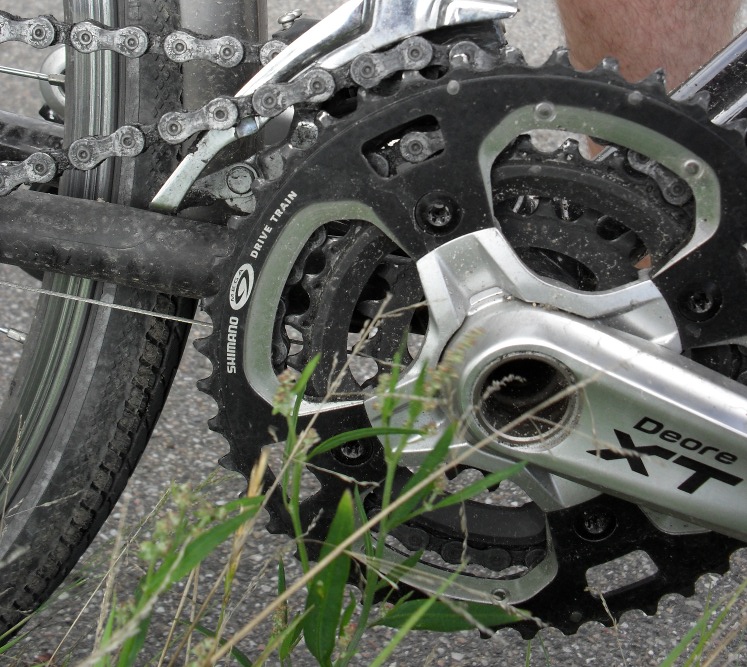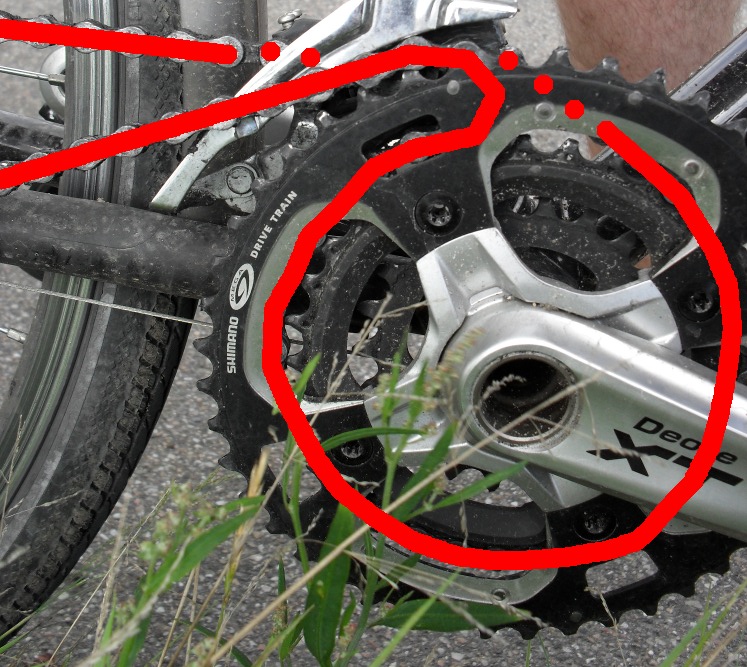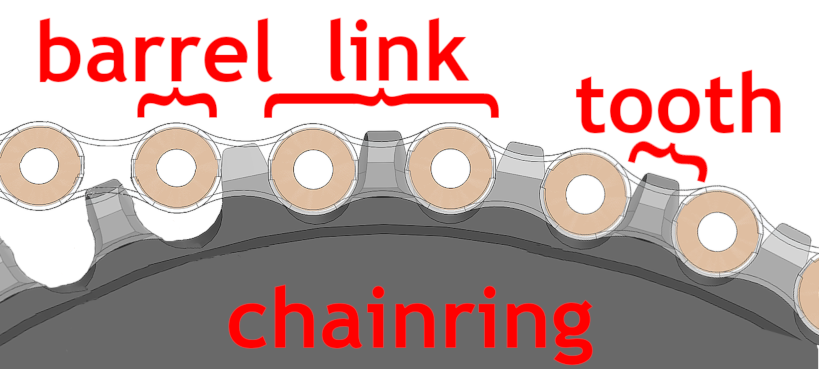Introduction
This page is about “chainsuck”: a problem whereby the bicycle chain repeatedly jams up in the front gear changer, as show here:

It’s difficult to understand the causes of this problem. Even bicycle repair shops may not be familiar with it and their actions can actually make the problem worse!
Credit to Jonathan Levy, who wrote a very comprehensive article on the subject, which unfortunately is not available on the web any more, although it is available from the internet archive, hence the expansion of this article.
What happens?
- while pedalling, the chain fails to disengage from a chainring (as if the chainring were sucking on the chain)
- the cyclist doesn’t immediately notice the problem (because – for a brief moment – everything feels the same) and continues to pedal, thereby turning the chainring a little further
- the chain gets pulled up by that point on the chainring from which it failed to disengage
- when that point reaches the front gear changer then the chain gets jammed in the narrow gap between the largest chainring and the changer
- pedalling comes to an abrupt and dangerous stop!
Here’s the same picture, but with the chain traced out for clarity:

What causes chainsuck? The short version
Either:
- the chainring is worn and the chain is worn, or
- the chainring is worn and the chain is new (this is typically worse than the first case)
What causes chainsuck? The long version
Here’s a picture to explain some terms:

Over time, bicycle chains stretch a very small amount. This is absolutely normal.
While cycling, two relevant things are happening on the upper horizontal section of the chain, close to the gear changer:
- the links are “descending” onto the chainring’s teeth
- this upper horizontal section of chain is under tension
Normally, the links descend perfectly onto each tooth.
That means two things:
- the teeth are not worn by the constant engaging and disengaging (because each link’s barrels descend symmetrically on either side of the tooth)
- the upper horizontal section of chain is held in tension by all teeth on that half of the chainring that is in contact with the chain, so all teeth are pulling on the chain (to make the back wheel turn) equally.
But on a stretched chain, the links descend slightly off-centre onto each tooth.
That means two things:
- the barrels “chafe” the teeth on one side, eventually leading to shark-fin-shaped teeth with a definite “cup” on one side
- the upper horizontal section of chain is held in tension more by the teeth that are about to disengage from the chain than by the other teeth on that half of the chainring that is in contact with the chain
And the combination of those two things mean that the tooth that is about to disengage from the chain may keep the barrel hooked on! And that’s chainsuck!
If the chain is replaced then:
- the barrels of the links are now sitting equally deeply inside the “cup” of the shark’s fins, so they are all pulling equally on the chain (sounds good, right?)
- but the barrel that is about to disengage from the chain needs to “climb out of the cup” in order to disengage, but to do that it needs to pull the other links on the chainring forward to get some slack, and because they are now under tension again, they resist this, meaning that the barrel may not “climb out of the cup” and so may not disengage.
So replacing the chain can actually make things worse!
How to diagnose chainsuck
- does your chain get pulled round the chainring as shown in the picture above?
- are the teeth on any chainring shark-fin-shaped?
How to remedy chainsuck
- replace the worn chainring
- If the chain is stretched (see below) then replace it
How to avoid chainsuck in the future
- buy a cheap chain measuring tool like this one
- familiarise yourself with how to use it
- measure your chain regularly
- change your chain when the tool tells you to
FYI: for normal city cycling, I get about 2000Km out of a chain. When touring (with more hills and loaded paniers causing extra chain tension) then I get half that.
